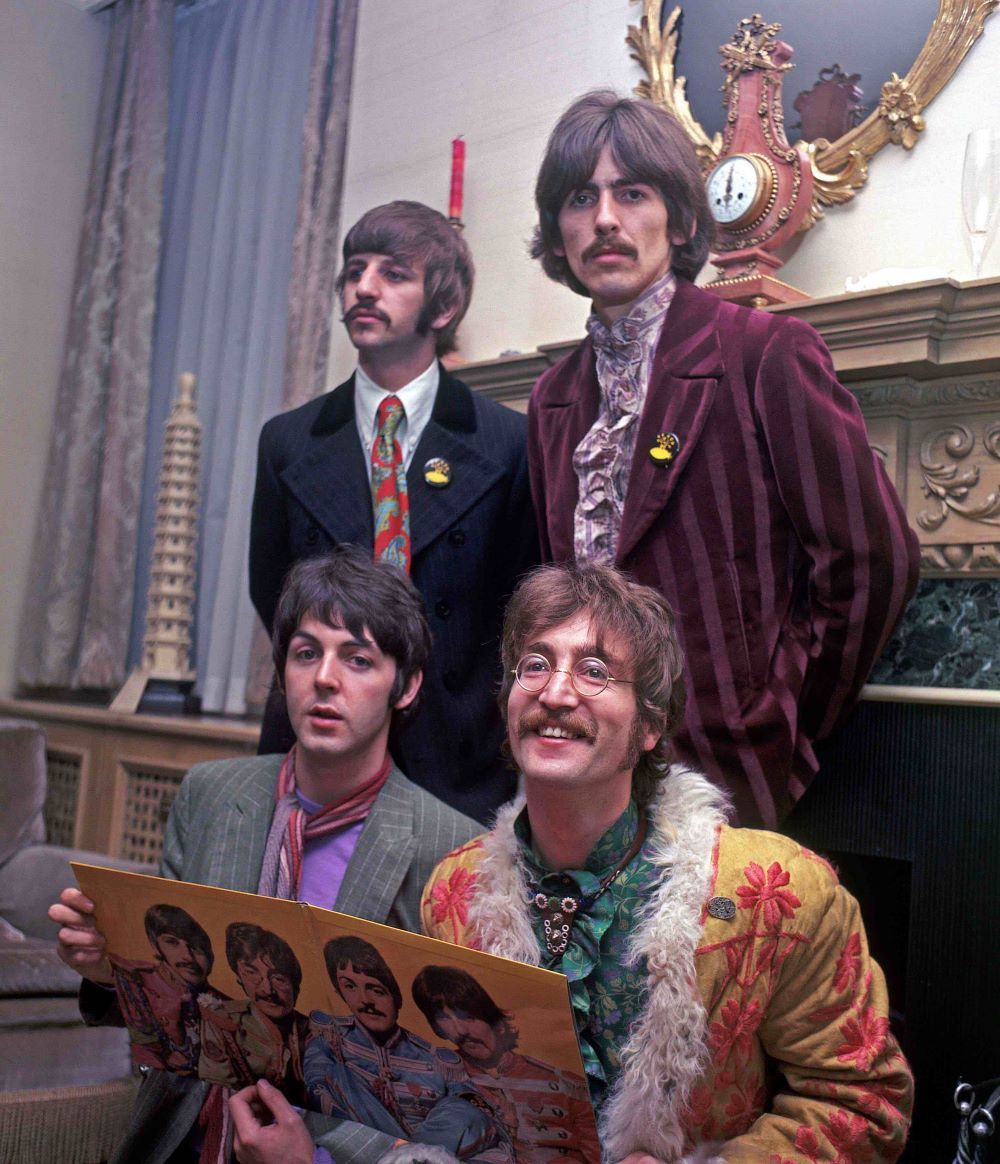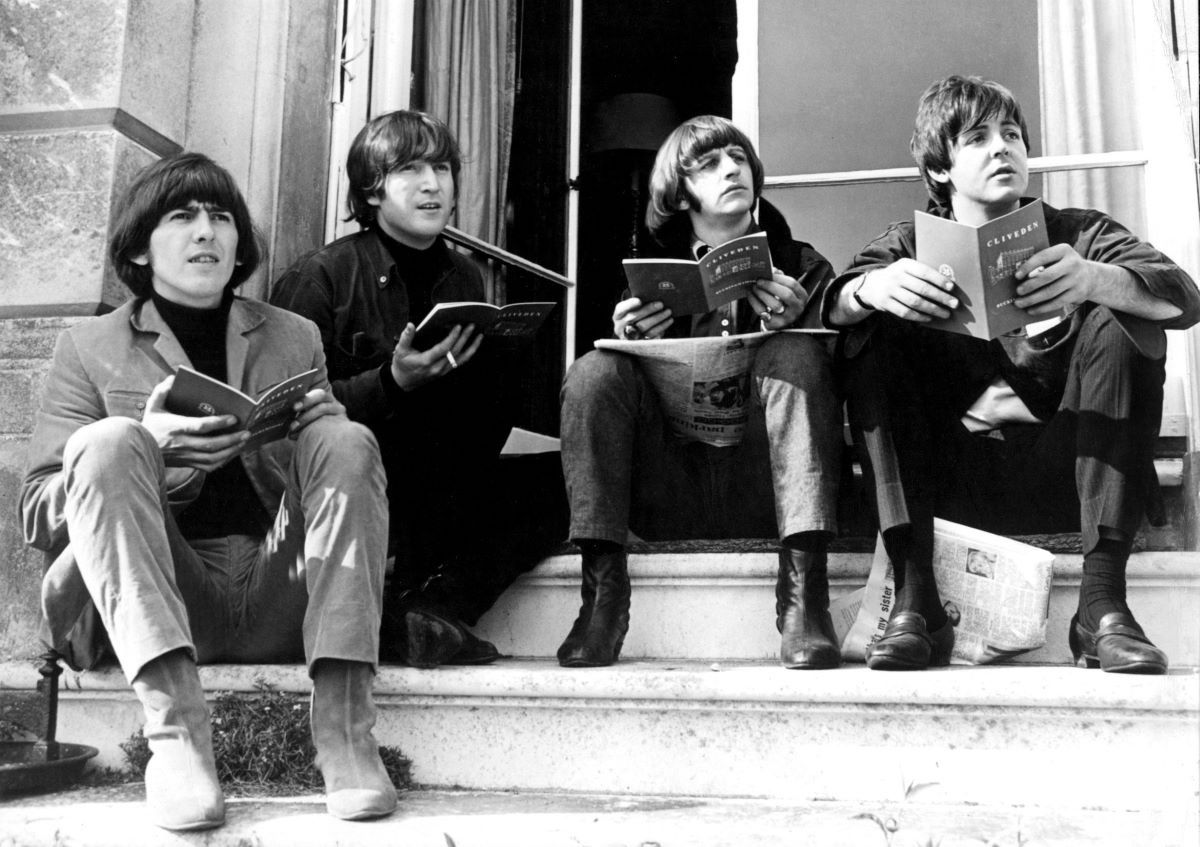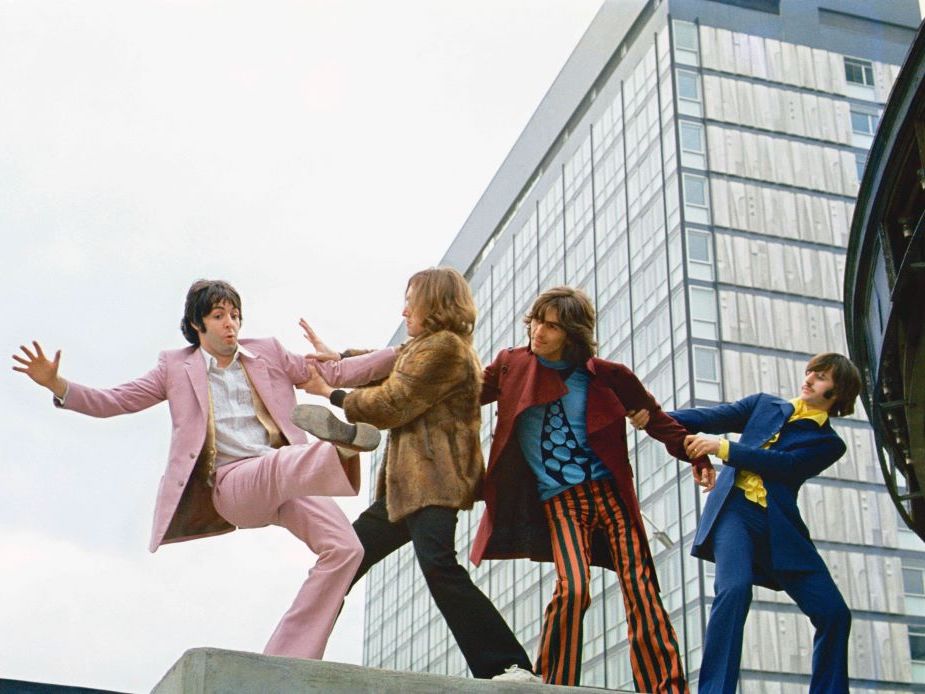- Fashioning the Beatles: The Looks That Shook the World
- Sutherland House Books (2023)
Rock star clothes. When you read those words, what comes immediately to mind? Elvis’s blue suede shoes, Jimi Hendrix’s fur and feathers, the whirling dervish capes of Stevie Nicks? Or the Beatles in their varied sartorial glory?
Toronto journalist Deirdre Kelly’s new book, Fashioning the Beatles: The Looks That Shook the World, takes on the quartet of trendsetters, from the earliest incarnation of the band, leather-jacketed and greased up, to the later peacock period of Sgt. Pepper. It’s an encompassing look at how the band influenced culture, and how culture shaped them.
A longtime Beatles fan, Kelly came to her subject quite intuitively. But in any period of deep research, it’s the unexpected perambulations and tangents that prove the most fascinating.
The Beatles may have set the tone for style, but the various cultural epochs through which they lived were indicative of how much fashion is reflective of the greater zeitgeist. The tumultuous years spanning the mid-1950s to the 1970s saw some of the most radical cultural shifts in the 20th century. And fashion occupied an interesting place — it drove and was driven by changes in the fabric of society.
Kelly’s deep dive is fascinating stuff. A buffet of style, the book overflows with anecdotes, photos, band lore and stories about the differing social periods that the Beatles traversed.
The Tyee posed a few questions to Kelly about the band, the clothes and, of course, the music. This interview has been lightly edited for length and clarity.
The Tyee: I was kind of surprised that no one had ever written about the Beatles and their relationship to fashion, given how immediate and overt it was.
Did you have one of those epiphany-type moments or was it a gradual realization that this was a motherlode of a subject yet to be fully explored?
Deirdre Kelly: It is very much a short answer — it was an epiphany. I did mention this a bit in the acknowledgments to the book because it really was an idea that I must credit to my husband.
So now here’s the long version: I have done two books prior to this, both with Vancouver publisher Greystone Books. I had wanted to do a third book, and we were in discussions about it being a fashion book because at the time I had been reassigned to the fashion beat at the Globe and Mail.
The thought was to capitalize on my expertise, much as we had done with my Ballerina book, which stemmed from my decades working as a dance critic for Canada’s national newspaper.
There was a lot of back and forth with proposals and ideas, all in pursuit of a subject that hadn’t been written about before. It was hard to find one. So, it was just one of those moments where I was bellyaching really to my long-suffering husband, who was trying to make himself a coffee in our kitchen.
I was yammering at him, bemoaning my inability to come up with a topic that had not been much examined before. I thought he was ignoring me, but then without lifting his head from the stirring of his Nescafé, he quietly said that I had it all wrong.
“Your next book has to be about the Beatles,” he said.
With hands on hips, and convinced now he really hadn’t heard a word I had been saying, I impatiently inquired, “Why?”
And he said, “Because you are Beatles obsessed.”
“True,” I responded. “But what could I possibly ever say about the Beatles that hasn’t been said before?”
And then, only because I had fashion on the brain and wanted to bring the conversation back to what was vexing me, I said, “Unless, of course, I was to write about their fashion.” I had meant it as a joke, but as soon as I said the words “Beatles" and "fashion,” practically in the same sentence, I became rooted to the spot.

In reading your book, I was struck by details and aspects of their performances that I’d never really thought about before. I’m thinking about the rendition of “Get Back” on top of the roof of Apple headquarters, and the respective outfits worn by each band member. After reading that chapter, I rewatched the video, and knowing more about what they were wearing added another layer of complexity and nuance to the action.
This was something of a pattern, with clothing manifesting the inner workings of the band — from unitedly cute to something more complicated and adult.
But you make the point that even when they were on the verge of dissolution, they still dressed/looked like a group. Was fashion something of an unspoken but still binding force throughout?
Yes. Fashion was a bond. It was there at the beginning and there at the end, a shared passion as much as music. John, Paul, George and Ringo understood the power of clothes to create an identity and reflect a mindset. They dressed not just for success but for self-expression, and to make themselves noticed for being different than any other group that had come before them or would follow.
The Beatles dressed to be true to themselves. They were style leaders who became the biggest trendsetters of their era, even when that had never been the goal.
For a group so exhaustively, almost forensically covered, was there particularly surprising information that emerged in researching the book? The Canadian connection with the story of Le Château and the velvet jumpsuits is a corker. The details of the Abbey Road cover are also fascinating.
Thanks for mentioning that. John Lennon’s Le Château black velour jumpsuit, immortalized in the cover of the Hey Jude album, was definitely a revelation for me. It took me years to uncover its Canadian origins. I thought it was European at first, from a designer such as Ted Lapidus, one of the first couturiers to triumph in what was called unisex fashion. I received confirmation from Le Château founder Herschel Segal himself. He had met John and Yoko in Montreal in 1969 at their bed-in.
There were other surprises, besides — George jump-starting the acid-wash denim trend, for example, and discovering corduroy, which the Beatles popularized, was initially an unfashionable cloth, reserved for the working class.
By wearing corduroy as they did — jackets and even customized footwear to match their bespoke outfits — the Beatles signalled their essential nonconformist and subversive nature.
There’s a quote in the latter part of the book where John Lennon references how the band’s changing styles affected public perception of them: “I guess they didn’t like how the image was looking. No reason to protect us for being soft and cuddly anymore — so bust us!”
As the band grew out of their mop-top phase and left behind their more innocent look, how did fashion play a part in this maturation and individuation process?
Fashion mirrored what was going on with the Beatles at every stage of the game. That’s what ultimately makes it such a fascinating topic. It’s not just clothing. It’s a band identity, and a reflection of the quest for artistic innovation and excellence.
The Beatles were no slouches. They worked extremely hard, held to a punishing schedule of creative output — especially during the Beatlemania period — and pushed themselves relentlessly forward, to the toppermost of the poppermost, as John used to say.
Their artistic evolution was a constant, resulting in no two records ever sounding the same and a dazzling array of looks that changed as they changed, season to season, album to album.
When they dressed in suits — something they all wanted to do despite what you might have read — it was to enable them to reach a new mass audience through the new medium of television.
They were cunning and canny about that, believing (quite rightly, it turned out) that a change of dress would presage a change of fortune. They dressed alike in those days as a matter of course for the stage. But they are so in synch that they often dressed alike even when they didn’t need to.
As they matured as musicians and as men, they never lost their bond through clothing. The garments might not have been identical, but they continued to showcase a shared sensibility.
Their fashion choices also reflected the volatility of their era, a time when creativity and youth usurped tradition and the status quo as cultural imperatives. It was all intimately connected.
Can you talk about your own relationship with the Beatles, how you first came to listen to them? Do have a favourite fashion period for the band? Also, I have to ask, a favourite Beatle?
The Beatles have been a part of my life since I can remember. Their music was a constant for me growing up, on the radio, and on vinyl. I was 10 when I bought my first Beatles album with my own money — Magical Mystery Tour.
The single “I Am the Walrus” bewitched me as soon as I heard it on a transistor hidden under my pillow. It bewitches me still. I papered my childhood room with Beatles posters; I read everything I could about them at a young age. I wrote school essays and did public speaking assignments on them.
By Grade 7, I was signing my artwork “Deirdre Lennon Kelly.” I also had an alias, Rita McCartney, that I used when being truant at my friends’ high school.
As a Globe and Mail staff writer, I got to write about them again. I interviewed Ringo for my paper, and reviewed Paul in concert in Halifax. I later met Paul when I crashed a New York City party where I knew he’d be guest of honour. This wasn’t that long ago. I remain Beatles mad.

Who’s my fave? I definitely can’t say. I love each for different reasons.
I have two favourite fashion periods: 1965 around the time of Help! — love the length of the hair, the East-meets-West clothing styles, the sexiness exuding from the we’re-great-and-we know-it attitude. They’re smoking a lot of weed at this time and it’s making them come loose at the seams.
I also adore their late Beatles look, 1968 on to 1969, when the look isn’t as much fashion as it is anti-fashion — in other words, a pure distillation of individual style.
When you look at photos from this period you can see so many iconic Beatles garments melding together — the pointed-toe boots, the distressed denim, the androgyny which the Beatles trail-blazed as a mainstay of pop culture. It is here represented by flowing silk scarves, transparent fabrics and (on Paul) the colour pink. They are like chameleons, ever changing their polka dots to keep us fascinated — and forever turned on.
Happy holidays, readers. Our comment threads will be closed until Jan. 2 to give our moderators a much-deserved break. See you in 2024! ![]()
















